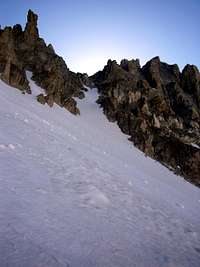|
|
Route |
|---|---|
|
|
40.06700°N / 105.638°W |
|
|
Mountaineering, Ice Climbing |
|
|
Spring, Summer |
|
|
Most of a day |
|
|
Steep snow |
|
|
II |
|
|
Overview
Isabelle Glacier is nestled in the cirque rimmed by the stretch of the Continental Divide that connects Shoshoni Peak to Apache Peak. From the south side of the glacier, Queen's Way majestically rises toward the summit of Apache Peak. Opposite to Queen's Way are three couloirs that run through the escarpment that forms Shoshoni's southwest face.The easternmost couloir is moderate in angle and reaches a notch on the east ridge of Shoshoni that separates the South Buttress from the main summit. The other two couloirs run almost parallel up to the Divide to the west of Shoshoni's summit. The central couloir is a rather uniform slope with an angle of about 45° for most of its length. The westernmost couloir is steeper and cut at about a third of its height by an even steeper rock band. The two couloirs are separated by a granite pillar that tapers at the top and are flanked by more towers and buttresses. The Isabelle Glacier cirque is one of the most beautiful places in the Indian Peaks wilderness and has a very alpine feeling.
Getting There
From the Long Lake trailhead, follow the Isabelle Glacier Trail to Lake Isabelle. The trail follows the north shore of the lake and continues toward the glacier, but when the couloirs are climbable, it is likely to be buried in snow above Lake Isabelle. In that case, simply continue along the line of least resistance leaving Shoshoni Peak to your right. Climb the moraine that surrounds the glacier and skirt the tarn at the base of the glacier to get to the couloirs. From the Long Lake TH to the base of the couloirs is a bit over four miles. Early in the season, you may have to add the distance from the road closure.Route Description
The couloirs are best climber in late Spring or early Summer. They are melted out by August. According to Roach, the easternmost couloir is the first to go. At the beginning of the season, there may a cornice at the top of the west and center couloirs and, obviously, one has to watch out for avalanches. The elevation gain is about 500 feet.Of the three, the westernmost couloir is by far the most interesting and challenging. Passing the rocky headwall is the crux. There are two options. The first is to climb the rock rib to the right of the couloir (reportedly 5.2). The second option is to stay in the couloir and tackle a chockstone encrusted with ice. This may be quite problematic when the crux is even partially melted out. The exit is very steep and is surmounted by a cornice early in the season. The center couloir is straightforward, with an angle of about 45° for most of its length. The exit is steep to the left, but eases to the right. The east couloir is of moderate angle. I climbed the west and center couloirs.
From the top of the couloirs one reaches in a few minutes the summit turret of Shoshoni--quite a remarkable perch. From there, the most direct descent option follows the east ridge, where, however, it is not difficult to cliff out and have to execute a couple of backtracks. A simpler but longer descent traverses along the Continental Divide to Pawnee Pass. In both cases, follow the Pawnee Pass Trail to Lake Isabelle. Note that snow may make it difficult to follow the trail and you may get mired in krummholz.




